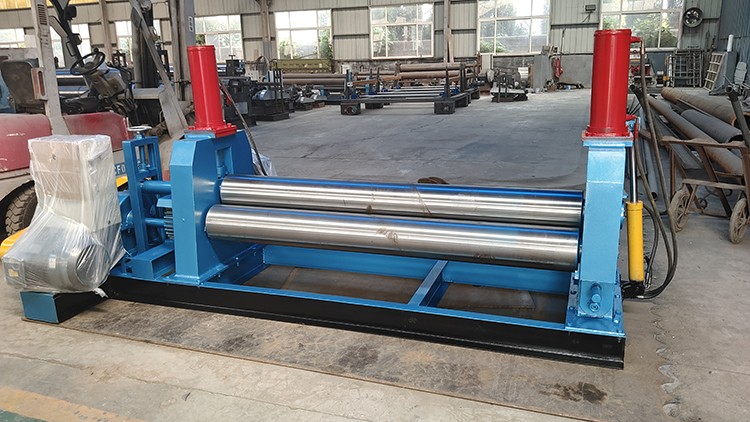


Plate rolling machines are important equipment in metal sheet processing. The rollers, as components that directly contact the sheets, are subjected to long-term pressure and friction, making surface wear inevitable. If wear exceeds the permissible range, it not only affects the forming quality of the sheets but may also cause equipment malfunctions. Therefore, regular inspection of roller wear and timely repairs are critical to ensuring stable equipment operation. This article will introduce methods for detecting roller shaft wear and repair standards, providing guidance for practical operations.
1, Common types of roller shaft wear
Roller shaft wear mainly manifests as uniform wear, local indentations, and scratches. Uniform wear is the overall thinning of the roller shaft surface, usually caused by long-term use; local indentations are often caused by hard object impact or local overload; scratches may be caused by burrs on the edges of the plate or foreign objects being rolled in. Different types of wear have different effects on processing accuracy, so they need to be classified and evaluated during inspection.
2, Wear detection methods
The detection of roller shaft wear requires a combination of visual inspection and instrument measurement.
Visual inspection
After shutting down the machine, first clean the oil stains and debris from the roller shaft surface, and observe whether there are obvious scratches, pits, or peeling. Focus on checking the area where the roller surface contacts the plate. If abnormal marks are found, further measurement is required.
Dimension measurement
Measure the diameter of the roller shaft at different positions using an outside micrometer or laser rangefinder. Select at least three cross sections along the length of the roller shaft, measure four directions (up, down, left, and right) at each cross section, record the data, and compare it with the original dimensions. If the diameter deviation exceeds 0.1 mm, or the local dent depth exceeds 0.05 mm, repair is required.
Roundness and cylindricity inspection
Check the roundness and cylindricity of the roller shaft using a dial indicator or coordinate measuring machine. If the roundness error exceeds 0.05 mm or the cylindricity error exceeds 0.1 mm, the roller shaft may not be able to ensure uniformity in sheet forming.
3, Wear repair standards
Based on the extent of wear, repair methods are categorized into minor grinding, weld repair, and roller shaft replacement.
Minor grinding
Applicable to uniform wear or superficial scratches. Use fine grinding wheels or polishing tools to remove surface damage. After grinding, ensure that the diameter deviation is within ±0.05 millimeters and the surface roughness does not exceed Ra1.6 micrometers. After grinding, the parallelism of the roller shaft must be recalibrated.
Weld repair
Localized dents or deep scratches can be repaired using weld overlay. Select welding wire that matches the material of the roller shaft. After welding, annealing treatment must be performed to eliminate internal stress. The repaired area must be machined to be flush with the original surface, with a hardness deviation not exceeding HRC5.
Replacement of roller shaft
If wear causes the diameter to decrease by more than 5% of the design value, or if there are through cracks, the roller shaft must be replaced. The material, heat treatment process, and precision of the new roller shaft must comply with the original manufacturer's standards. After installation, it must undergo no-load trial operation and load testing.
4, Acceptance requirements after repair
The repaired roller shaft must meet the following conditions:
Diameter tolerance not exceeding ±0.1 mm;
No visible cracks or unfused weld points on the surface;
Vibration amplitude less than 0.05 mm in dynamic balance testing;
No indentations or wave-like deformation on the formed sheet metal during trial operation with material.
5, Measures to prevent wear and tear
The following measures can be taken to extend the service life of the roller shaft:
Clean the roller surface regularly to prevent metal debris from accumulating;
Remove burrs from the edges of the sheet metal before processing;
Adjust the roller shaft pressure according to the hardness of the sheet metal to avoid overload operation;
Conduct a comprehensive inspection and lubrication maintenance of the roller shaft every six months.
Wear management of roll forming machine rollers is an important part of equipment maintenance. Through scientific testing methods and standardized repair processes, the impact of wear on processing quality can be effectively controlled. Operators should flexibly apply standards based on actual conditions to ensure that equipment is always in optimal condition.
If you are interested in plate rolling machines, please contact us.
 Address:Room 1202, Detaitang Building, No. 118 Huaguang Road, Zhangdian District, Zibo, Shandong
Address:Room 1202, Detaitang Building, No. 118 Huaguang Road, Zhangdian District, Zibo, Shandong WhatsApp:+8615653328535
WhatsApp:+8615653328535 Wechat: +8615965331535
Wechat: +8615965331535  E-mail:zs@sdsmachinery.com
E-mail:zs@sdsmachinery.com